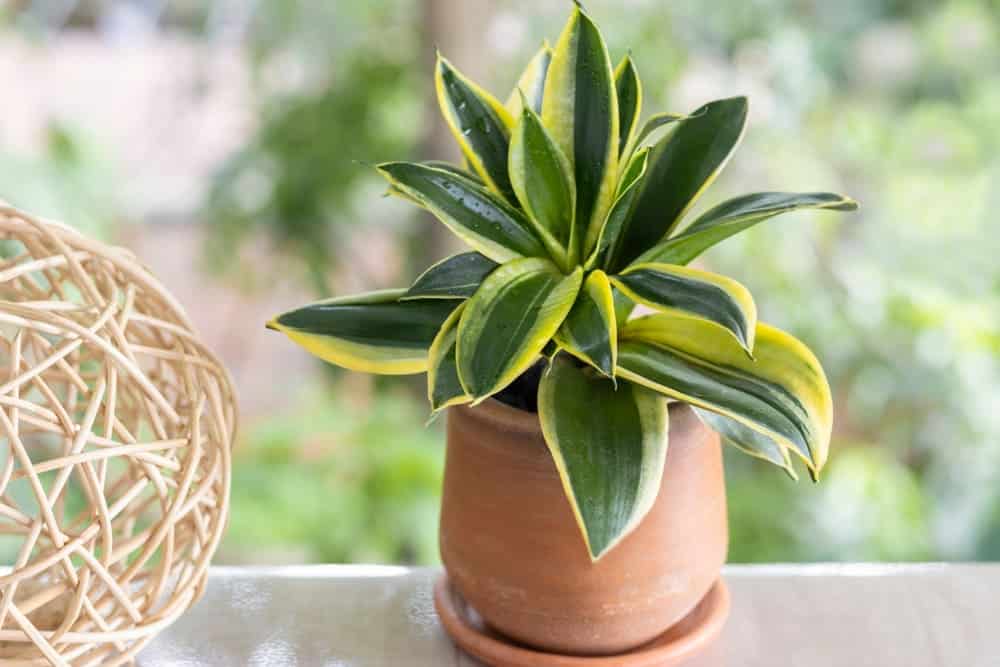Here is a detailed description of snake plant toxicity, along with key takeaways for anyone considering these plants if they own dogs:
Snake Plants and Dogs: Important Safety Considerations
Snake plants (also known as Mother-in-Law’s Tongue) are stylish and easy to care for, making them popular houseplants. However, dog owners must be aware that these plants are mild to moderately toxic to dogs.
Why Are Snake Plants Toxic to Dogs?
- Saponins: Snake plants contain natural chemicals called saponins. These are a defense mechanism against pests and diseases. Unfortunately, saponins are poisonous to dogs if ingested.
Symptoms of Snake Plant Poisoning
If your dog eats part of a snake plant, watch for these signs:
- Digestive Upset: Nausea, vomiting, diarrhea
- Behavioral Changes: Drooling, loss of appetite, lethargy
- Skin Irritation: Swollen mouth, especially if the sap touched their mouth or tongue.
- Severe Cases: Elevated or irregular heartbeat.
What to Do if Your Dog Eats a Snake Plant
- Remove the Plant: Secure the plant out of reach and clean up any dropped leaves.
- Wash Your Dog: Bathe your dog with warm, soapy water to remove sap from fur and paws. Rinse their mouth with water only (not soap).
- Monitor and Hydrate: Watch your dog closely for 24-48 hours and offer plenty of water.
- Contact Your Vet: Call your veterinarian immediately, especially if symptoms show. Explain what your dog ate and if any symptoms are present.
Prevention is Key:
- Training: Teach your dog “leave it” commands.
- Placement: Keep snake plants on high shelves or in closed-off rooms.
- Repellents: Use natural deterrents like citrus or vinegar sprayed near the plant.
Key Takeaways
- Snake plants are toxic to dogs, though rarely fatal.
- Symptoms are primarily related to digestive upset.
- Contact your vet immediately, even if symptoms seem mild.
- Prevention is the best way to keep your dog safe.
Remember, responsible pet ownership includes being aware of potential dangers in your home. By understanding the risks and taking precautions, you can enjoy both your snake plants and your furry companion safely.
Are Snake Plants Toxic to Dogs?
Unfortunately, snake plants are harmful to dogs. They contain saponins, a naturally occurring chemical that is poisonous to your dogs if consumed. Although snake plant poisoning seldom results in death, your dog will experience discomfort and an upset stomach if they do consume any of the plant’s pieces. Saponins, a toxin found in snake plants, can harm your dog.
In most situations, snake plant poisoning is moderate, but it can potentially be serious and cause your dogs’ blood cells to rupture. It is crucial to take your pet to the veterinarian at the first indication of snake plant poisoning. Delays in treatment may aggravate the symptoms and lengthen the time it takes to heal.
Why Snake Plants Are Toxic to Dogs?
For defense, the snake plant creates chemicals called saponins. To stop animals from eating its fruit and foliage, snake plants and many other indoor plants use poisons. In actuality, saponins aid snake plant defense against some typical bacteria and fungi.
Saponins are present in the roots and foliage of snake plants as well. However, the skin of the leaves has the highest concentration of saponins. Actually, the waxy covering on the snake plant’s vertically extended leaves is a result of saponins.
The saponins in a snake plant will start irritating the gastrointestinal tract and stomach lining if a dog ingests any part of it. Unfortunately, your pet will experience much discomfort as a result, and they will start to show symptoms.
Moreover, rashes, itchiness, and swelling of the skin are all known side effects of the snake plant’s sap. This typically implies that any exposed skin will swell and itch when the sap touches it.
Symptoms of Snake Plant Poisoning in Dogs:
Saponins are toxins produced by the snake plant and can have a number of negative effects when our dog consumes them. Red blood cell rupture results from the toxin’s intense gastrointestinal activity. The foaming action of saponins brings on gastric distress. They also cause cell death by interfering with regular cell mechanisms. Now, let us focus on the signs to watch out for if you think your dog may have consumed snake plant components.
- Nausea or Vomiting:
As was already established, the primary impact of ingesting saponins is gastrointestinal tract inflammation. This may result in nausea, vomiting, and stomach discomfort.
- Behavioral Changes:
Unfortunately, your dog cannot communicate its feelings to you, so you may have to rely on seeing any odd behavior. For instance, excessive licking or drooling. They may also lose their appetite, which makes sense, given how agitated their digestive system is.
- Diarrhea:
When a snake plant poisons a dog, its body will attempt to digest and eliminate the harmful compounds in its system by causing diarrhea.
- Swollen Mouth:
A well-known irritant to whatever exposed skin it comes into touch with is the sap of snake plants. This implies that any areas of the mouth, nose, or tongue that come into contact with the sap are likely to become swollen, red, and irritated in the mouth.
- Increased Heart Rate
In more severe cases of snake plant poisoning, an elevated heart rate or an irregular heartbeat may appear. You might see your dog’s heart pounding quickly or detect irregular heartbeats.
What To Do If Your Dog Consume Snake Plant?
It may be fatal for your pet if it consumes the plant in excessive amounts. To safeguard both your plants and pets, you must be cautious about all of these things. We advise using the following procedure to treat your pet if you observe any of the symptoms above.
To avoid additional poisoning of your dog and other pets, remove the snake plant and any fallen pieces that may be on the ground right away. To get rid of any remaining sap that could be on your dog’s skin, paws, or fur, give them a warm, soapy bath. Your dog’s mouth should be washed with water, not soap. We want to prevent their system from absorbing any additional poisons.
For the following 24-48 hours, keep a tight eye on your dog. As their body works to break down and get rid of the saponin poisons from their system, they will probably wish to rest. Especially if they are vomiting or have diarrhea, make sure they have access to plenty of water.
It’s critical to act quickly to protect your dog and the snake plant if your dog consumes the plant. Try to keep your composure first.
Dogs can become poisoned by snake plants. However, the degree of the poisoning varies depending on the amount consumed and the size of your dog. Keep an eye out for any immediate signs of discomfort, such as vomiting, diarrhea, or persistent drooling. Though certain signs may take longer to manifest, it is important to watch your dog regularly.
Inform your veterinarian about the situation as soon as possible. Based on the particular circumstances affecting your dog, they will provide you with advice. Telling them which plant parts your dog ate and whether any symptoms have already appeared is helpful.
If it has been a specific amount of time since consumption, your veterinarian can advise you to induce vomiting. Inducing vomiting can sometimes be hazardous, so avoid doing so without first consulting a medical practitioner.
The veterinarian will administer any more therapeutic drugs as needed. She might give your dog an antiemetic if she is violently vomiting. If he is having digestive distress, medication to protect the lining of the stomach and intestines may be administered. Based on his symptoms, your dog will receive extra treatments.
How to Prevent Your Dog From Eating Your Snake Plant:
You may take a few easy precautions to prevent snake plant poisoning in your adorable pet dogs. This includes keeping your pet’s green pal out of your dog’s and other animals’ reach. So, let us know how to prevent your dog from eating snake plants.
- Train Your Dog:
You must outsmart your pet if you do not want to get rid of the good luck plant. Train your dog to know what foods are acceptable and which areas are safe to explore to keep it safe. This crucial instruction can aid in reducing the risk of snake plant poisoning. The best time to begin this type of training is when your dog is still a puppy. Your pet will eventually start automatically respecting its boundaries as they get older.
- Keep It Out Of Reach:
The next piece of advice is to store the snake plant in places where dogs are not permitted or inaccessible locations like high shelves.
You may need to be creative and redecorate your home, depending on the size of your pet, to keep a healthy balance between indoor plants and your pet.
Close the room’s doors after placing the snake plant in there. Even while you are not there, it will make sure that your curious pet does not enter this space.
- Use Repellent Smell:
Another method of preventing your pet from accessing these plants is to spray natural repellents on the plant. On the plant or close to the plant, a small amount of vinegar or liquid from citrus fruits can be sprayed. Make sure to convey this information to your kids. Your pet will naturally avoid the mother-in-law’s tongue and be repulsed by the smell of zesty components.
Conclusion:
Snake plants may add a touch of elegance to our homes, but it is important to remember that they can pose a risk to our beloved canine companions. Make sure to stop your dog from eating snake plants because prevention is key.
Let us prioritize our furry friends’ safety, well-being, and enjoyment as responsible pet owners by remaining knowledgeable about potential risks. We can ensure our pets stay healthy, happy, and safe in their forever homes with love, care, and awareness.


